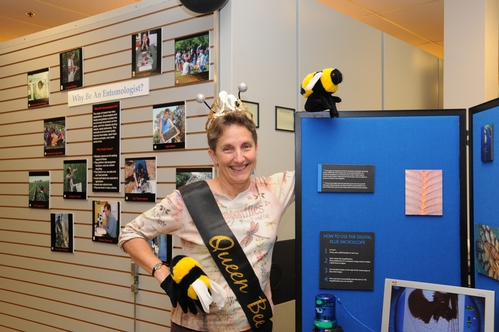Pollination Nation.
That's the title of a new display at the Bohart Museum of Entomology, University of California, Davis.
It's quite timely and appropriate because of the beleaguered bees.
Lynn Kimsey, director of the Bohart Museum and professor and vice chair of the UC Davis Department of Entomology, has a keen interest in bees, and not just because she's an entomologist and a former beekeeper. She's instrumental in the administrative aspects of the Harry H. Laidlaw Jr. Honey Bee Reseach Facility, including the newly planted Häagen-Dazs Honey Bee Haven, a half-acre bee friendly garden. Plans call for a public open house June 19.
And if you ever want to check out the wide variety of bee specimens (from honey bees to carpenter bees to sweat bees to blue orchard bees, et al), be sure to visit the Bohart. Bees are among the seven million insect specimens housed there.
The Pollination Nation display emphasizes the importance of bees. "Approximately three quarters of all flowering plants rely on animals, mostly insects, for pollination," the display reads. "Wild insect pollinators include bumble bees, flies, solitary bees, butterflies, ants, beetles and wasps.”
“Farmers rely heavily upon the managed colonies of the European honey bee (Apis mellifera) to pollinate crops. Not only do honey bees help produce our food but they also provide us honey and wax. Recently honey bee colonies have been dying off and their numbers are declining. Disease and mites may be the root of the problem, but insecticides and habitat loss also pose serious threats.”
Researchers at UC Davis, Kimsey explained, are trying to "understand and solve the problems of declining pollinators, both native and domesticated, by studying their taxonomy, ecology, life history traits, diseases and behaviors."
The Bohart Museum, located in 1124 Academic Surge, was founded in 1946 by the late Richard M. Bohart, former chair of the UC Davis Department of Entomology. Dedicated to teaching, research and service, the insect museum houses the seventh largest insect collection in North America.
The museum also includes live insects such as Madagascar hissing cockroaches, walking sticks and walking leaves. “That’s our petting zoo,” Kimsey quipped. (Yes, you can hold them.)
More information about the Bohart, visiting hours, and guided tours is available from public outreach coordinator Tabatha Yang at (530) 752-0493 or tabyang@ucdavis.edu.
Attached Images:

Queen Bee

Pollination Nation